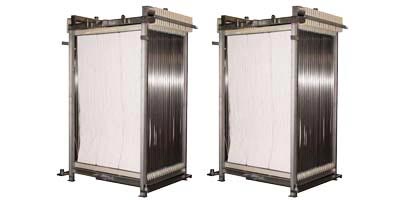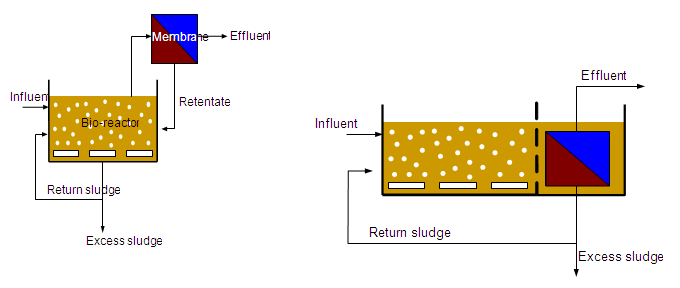How Membrane Bioreactor Contributes to the Reduction of Energy Consumption in Water Treatment
How Membrane Bioreactor Contributes to the Reduction of Energy Consumption in Water Treatment
Blog Article
Membrane Bioreactors Clarified: Reliable Solutions for Clean Water
Membrane bioreactors (MBRs) have actually become a sophisticated remedy for dealing with journalism challenges of wastewater treatment. By integrating organic processes with sophisticated membrane filtration, MBRs not just improve the top quality of treated water however additionally reduce the spatial needs of therapy facilities. As ecological problems heighten, the role of MBR modern technology in advertising sustainable water administration becomes progressively substantial. The intricacies of their operation, benefits, and possible applications merit a closer assessment to fully recognize their effect on the future of water therapy.

What Are Membrane Layer Bioreactors?
Membrane layer bioreactors (MBRs) are advanced wastewater treatment systems that incorporate biological degradation processes with membrane filtering technology. This combination enables the efficient elimination of pollutants from water, making MBRs a favored option in various applications, consisting of municipal wastewater treatment and commercial effluent monitoring.

One of the crucial benefits of MBRs is their capacity to create premium effluent, commonly suitable for reuse in watering or industrial procedures. Additionally, MBRs require a smaller sized impact contrasted to traditional therapy systems, making them suitable for urban setups where area may be restricted.
In addition, MBRs can efficiently handle varying influent tons and are less vulnerable to the impacts of poisonous shocks. These features add to their growing appeal as a sustainable solution for dealing with the enhancing need for tidy water while lessening ecological impacts.
Exactly How Membrane Bioreactors Work
While the operation of membrane bioreactors (MBRs) may appear facility, it essentially revolves around the synergy between organic procedures and membrane filtration. MBRs incorporate an organic therapy process, commonly activated sludge, with a membrane layer separation device to deal with wastewater successfully.
In an MBR system, wastewater is initial introduced right into a bioreactor where bacteria degrade raw material and other contaminants. The organic task decreases the concentration of toxins while promoting the growth of biomass. Following this biological treatment, the blended alcohol goes through membrane layer filtration, which can be microfiltration or ultrafiltration, depending upon the wanted effluent high quality.
The membranes serve as a physical barrier, permitting water and tiny solutes to pass while preserving put on hold solids and bigger molecules. This enables the system to maintain a high focus of biomass within the activator, enhancing the treatment efficiency.
Furthermore, the continuous separation of treated water from the biomass assists in a portable layout and reduces the footprint of the treatment center. On the whole, the mix of organic deterioration and membrane filtration in MBRs causes trustworthy and effective wastewater therapy, ensuring top notch effluent ideal for various applications.
Advantages of MBR Innovation
Among the key advantages of membrane layer bioreactor (MBR) innovation is its capacity to produce high-grade effluent you could look here with a significantly reduced footprint contrasted to standard wastewater therapy methods. MBR systems successfully combine organic therapy and membrane layer filtration, leading to premium elimination of contaminants, including put on hold solids, virus, and organic matter. This ability brings about effluent click site that commonly fulfills or exceeds rigid regulatory criteria for reuse and discharge.
Additionally, MBR modern technology permits for greater biomass focus, which boosts the treatment effectiveness and reduces the required reactor quantity. This small layout is specifically valuable in urban locations where space is restricted. The functional flexibility of MBR systems additionally suggests they can adjust to varying influent qualities and flow prices, making them suitable for a vast array of applications.
Furthermore, the minimized sludge manufacturing associated with MBR processes contributes to reduce operational and upkeep prices. The membranes offer as a physical obstacle, lessening the risk of blocking and enabling longer functional durations in between cleaning. On the whole, the advantages of MBR modern technology make it an eye-catching solution for lasting wastewater treatment, addressing both ecological issues and the requirement for effective look at more info resource monitoring.
Applications of Membrane Bioreactors
With their adaptability and effectiveness, membrane layer bioreactors (MBRs) find applications throughout different industries, including metropolitan wastewater treatment, industrial procedures, and also water recovery. In community settings, MBRs give a small service for dealing with wastewater, properly removing contaminants while all at once creating top notch effluent that meets stringent regulatory standards. This makes them especially suitable for locations with limited area.
In commercial applications, MBR modern technology is made use of for treating procedure water, specifically in markets such as food and beverage, pharmaceuticals, and petrochemicals. These markets profit from MBRs' capability to deal with high natural tons and their performance in recovering beneficial sources from wastewater, such as nutrients and water.
In addition, MBRs play a critical function in water recovery efforts, enabling the reuse of treated wastewater for irrigation, commercial processes, or also as safe and clean water after more therapy (Membrane Bioreactor). Their performance in getting rid of microorganisms and pollutants makes them a trustworthy choice for making sure water quality in various reuse applications
Future of Water Therapy Solutions
The future of water therapy remedies is poised for transformative improvements driven by technological advancement and increasing environmental recognition. As international water deficiency becomes a pressing issue, brand-new approaches, including membrane bioreactor (MBR) systems, are readied to play a pivotal role in improving the performance and sustainability of water therapy processes.
Arising technologies such as expert system and artificial intelligence are anticipated to maximize treatment operations, allowing for real-time surveillance and predictive upkeep. This will certainly boost the general integrity and efficiency of water therapy facilities. Developments in membrane layer products, such as graphene and nanofiltration, assure to increase permeation prices and reduce fouling, leading to lower energy usage and operational prices.
Additionally, the combination of renewable power sources into water treatment plants will certainly contribute to greener methods. The circular economic climate model will also gain grip, motivating the healing of valuable resources from wastewater, such as nutrients and power.
Final Thought

Membrane layer bioreactors (MBRs) have actually emerged as an advanced option for resolving the pressing difficulties of wastewater therapy. By incorporating biological processes with sophisticated membrane layer purification, MBRs not just boost the quality of treated water however additionally minimize the spatial demands of treatment centers.One of the vital benefits of membrane layer bioreactor (MBR) innovation is its capability to produce premium effluent with a substantially reduced footprint compared to traditional wastewater treatment approaches.With their flexibility and performance, membrane bioreactors (MBRs) locate applications across numerous industries, consisting of metropolitan wastewater therapy, commercial procedures, and even water improvement.In final thought, membrane bioreactors stand for a considerable innovation in wastewater treatment modern technology, incorporating organic processes with reliable membrane filtering to produce top notch effluent.
Report this page